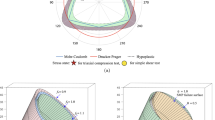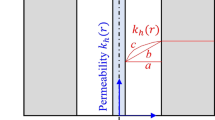Summary
Consolidation of soils occurs when the imposed loading produces strains accompanied by the slow escape of pore-water from the voids between the particles. This straining is accompanied by rolling and sliding of the particles into a more dense packing.Terzaghi realized that the plastic resistance to deformation, in the case of clay consolidation, was so small that the consolidation process could be considered as a hydrodynamic problem; in this way, he used simplifying assumptions which led to the development of a time-settlement relationship for clays based entirely on the escape of pore-water; this is a linear equation.
Consolidation theory gives a unique stress-strain-time relationship — provided that the strains are not sufficiently large to overcome the shear strength of the soil, with the consequence that rheological considerations govern the deformation process.
In the case of soft soils, especially organic soils, the volume of water expelled during consolidation is very large and the shear strength of the soils small. The experimental results indicated that, at low stresses, the strain rates were low indicating plastic deformation of the material with the process governed by the hydrodynamic theory — while at higher stresses, the strain rates increased causing the soil to flow in viscous form and the rheological behaviour predominated over the hydrodynamic process.
A further complication to theTerzaghi theory arises with soft soils having high water contents; during the consolidation process, the permeability is reduced as the particles assume a more dense packing.
A “Flow-Loading” parameter was obtained for the soils which incorporated the changes in permeability as a function of loading. This parameter was incorporated in the consolidation theory and provided a non-linear second-order differential equation which can predict the settlement-time behaviour as a function of both loading and changing soil properties.
Similar content being viewed by others
References
Gibson, R. E., G. L. England andM. J. L. Hussey The Theory of One-dimensional Consolidation of Saturated Clay, Geotechnique17, 261–273 (1967).
Hwang, C. T., Extending the Theory for the Primary Consolidation of Soils, M. Eng. thesis (McMaster University 1966).
Schroeder, J. andN. E. Wilson, The Analysis of Secondary Consolidation of Peat, Eighth Muskeg Research Conference, pp. 130–142 (1962).
Terzaghi, K., Erdbaumechanik (Wien 1925).
Wilson, M. E. andC. T. Hwang, The Influences of Varying Soil Properties on Consolidation. Advances in Consolidation, Seventh International Conference on Soil Mechanics and Foundation Engineering, pp. 74–80 (1969).
Wilson, N. E., N. W. Radforth, I. C. MacFarlane andM. B. Lo The Rates of Consolidation for Peat, Sixth International Conference on Soil Mechanics and Foundation Engineering, Vol. 1, pp. 407–410 (1965).
Author information
Authors and Affiliations
Additional information
With 6 figures
Rights and permissions
About this article
Cite this article
Wilson, N.E. Rheological influences on the consolidation process of soils. Rheol Acta 13, 840–844 (1974). https://doi.org/10.1007/BF01527082
Received:
Issue Date:
DOI: https://doi.org/10.1007/BF01527082




